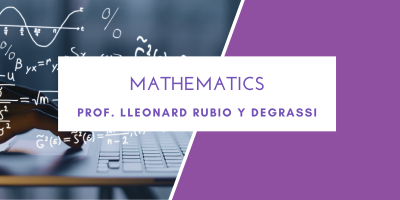Mathematics

Period: First semester
Course unit contents:
1.1 Mathematics - Analysis
Functions: definition; injective, surjective, bijective functions; composition of functions; existence and determination of the inverse of a function; graph of a function in a Cartesian plane;
symmetries and periodicity of a function.
Notable examples of functions: linear, quadratic, polynomial, rational, exponential, logarithmic, goniometric.
Exponential, logarithmic and goniometric equations and inequalities.
Limits: definition, calculation and verification; definition of continuity for a function.
Derivatives: definition and geometric interpretation; calculation of the derivative of a function; de l'Hôpital's rule for calculating a limit.
Function study: definition domain; growth and decrease; local maximum and minimum points; convexity and concavity; inflection points; asymptotes; synthetic summary of the information by approximation of the graph of the function.
Integrals: geometric definition and properties of the definite integral; definition and calculation of the indefinite integral; fundamental theorem and formula of integral calculus; techniques of integration by parts and by substitution; improper integrals.
1.2 Mathematics - Linear Algebra
Matrices: operations with matrices, invertible matrices, computation of the inverse matrix, determinant of 2x2 and 3x3 matrices.
Solving systems of linear equations with the Gauss method: general method and applications to examples with 1, 2 or 3 variables.
Vector spaces: definition; sum of vectors; product of a vector with a scalar; scalar product of vectors; Euclidean norm of a vector.
Lines in 2- and 3-dimensional vector spaces: Cartesian and parametric equations.
2. Statistics
Frequency tables and histograms.
Mean, median and sample variance.
Quantiles: definition and examples.
Sample space and events.
Probability function and its properties.
Inclusion-exclusion principle with some applications, product rule and conditional probability.
Independent events: definition and examples.
Bayes formula. Discrete random variables, expected value and moments of a discrete random variable.
Continuous random variables: definition and examples of uniform, exponential, normal, Student's t random variable.
Percentiles of normal random variables and Student's t.
Point estimators: sample mean and its distribution; application to the normal case.
Sample variance: definition and properties; application to the normal case.
Interval estimation and confidence interval: definition and examples; application to the normal case with known and unknown variance.
3. Informatics
Computer architecture: hardware & software.
Notes on operating systems.
Introduction to algorithms.
Introduction to spreadsheets.
Introduction to programming with Python: variables, operators, control structures, data structures, scientific modules (Numpy, matplotlib), modules for data manipulation and visualization.
Planned learning activities and teaching methods: The course is organized in lectures with the participation of students at the blackboard.
Most of the time is devoted to examples and exercises performed and discussed in class.
Some hours will be left to the students to try to solve problems independently, under the supervision of the teacher, available in case of doubts and questions.
The teacher's notes and lists of additional exercises are made available to students on the moodle platform, in the section dedicated to the course.
The teachers are available for clarifications.
In addition to contacting the course instructor, students with disabilities, Specific Learning Disorders (SLD), Special Educational Needs (SEN), and other health conditions can reach out to the Student Services Office - Inclusion Unit to receive more information about opportunities to access teaching with specific support and tools.
The use of generative artificial intelligence tools (e.g., ChatGPT) is discouraged in this course, especially for solving mathematical problems, as such tools often produce incorrect or misleading results.
